Fact:
On April 3, 2017, the day Vladimir Putin was due to visit the city, a suicide bombing was carried out in the St. Petersburg metro, killing 15 people and injuring 64. An al-Qaeda affiliate, Imam Shamil Battalion, claimed responsibility.
Following a rare U.S. airstrike targeting ISIS in Puntland, Somalia in early February 2025, recent media reporting highlighted the role of ISIS in Puntland for the global operations of this terrorism network. The growing threat by this particular ISIS affiliate (The Islamic State’s Somalia Province) is also reflected in a large-scale terror attack by this group at the end of 2024. On December 31, 2024, authorities in the Somali autonomous region of Puntland said eight foreign militants were killed following an attack by Islamic State fighters on security forces in the early morning. Residents said the attack started with a suicide bombing that targeted an area in Dharjale, Bari region in the far eastern highlands of Puntland, where security forces and officials were camped. Brigadier General Mohamud Mohamed Ahmed confirmed the attack: “Puntland anti-terrorism forces in the Dharjale, Bari region were attacked by the bloodsucking Daesh terrorist group (…) The security forces have been following their movements, and they were ready. The bodies of eight foreigners and their weapons have been displayed.” General Ahmed said Puntland security forces sustained “limited casualties.”
The attack also is a prime example of how ISIS propaganda channels exploit such attacks. On January 1, 2025, in the late afternoon, the Islamic State published a lengthy statement and pictures of the attackers. In the statement, translated below, the Islamic State provided more details on the attack and the attackers involved.
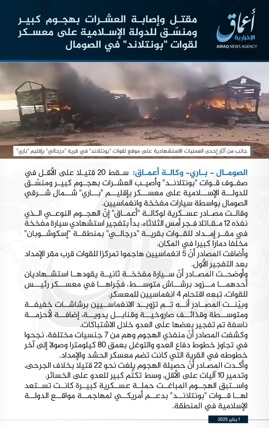
First the Islamic State published a statement via it’s A’maq News Agency later to be followed by pictures of the attackers involved, providing details on their nationalities.
The statement translates as follows:
“Dozens Killed and Injured in a Major and Coordinated ISIS Attack on a Puntland Forces Camp in Somalia
Somalia - Bari - Amaq Agency: At least 20 Puntland forces were killed and dozens were injured in a major and coordinated ISIS attack on a camp in the Bari region in northeastern Somalia using car bombs and Inghimasi [martyrdom seekers] fighters.
Military sources told Amaq Agency that the attack carried out by 12 fighters at dawn yesterday, Tuesday, began with a suicide bomber detonating a car bomb at a supply headquarters of the forces in the village of "Darjale" in the "Iskoshuban" area, causing massive destruction.
The sources added that five Inghimasi’s attacked a position of the forces near the supply headquarters after the first explosion.
The sources explained that a second car bomb driven by two suicide bombers, one of whom was equipped with a medium machine gun, detonated in a main camp, followed by four suicide bombers storming the camp.
The sources indicated that the Inghimasi’s were provided with light and medium machine guns, rocket-propelled grenades, and explosive belts, some of which were detonated on the enemy during the clashes.
The sources revealed that the attackers, who were from seven different nationalities, succeeded in crossing the enemy's defence lines and penetrating 80 kilometers deep, reaching the last lines in the village that included the base and supply camp.
The sources confirmed that the toll of the attack amounted to about 22 dead, in addition to the wounded, and the destruction of at least 10 vehicles, amid great secrecy by the enemy about the losses.
The surprise attack preceded a large military campaign that the "Puntland" forces were preparing for with American support to attack the Islamic State sites in the region.”
The A’maq claim was quickly followed by a statement published by a propaganda channel linked to the Islamic State Somali Province.
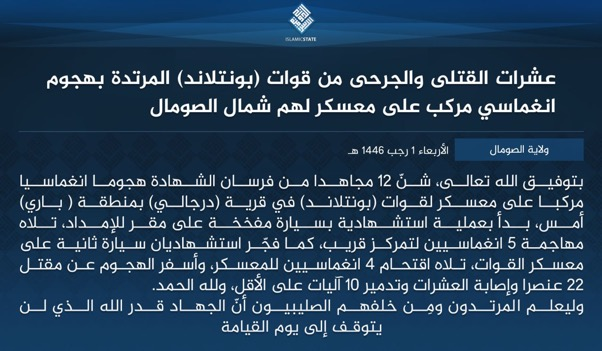
The most remarkable elements from these statements relate to the vehicle-borne improvised explosive device (VBIED) and person-born improvised explosive device (PBIED) attacks. Such attack methodologies were once one of the decisive terror tactics that contributed to the military success and rise of ISIS in its former heartland of Syria and Iraq. Attacks like these became more of a rare phenomenon in the last few years but it seems that ISIS aims to deploy them more frequently again. For example, ISIS operations in West Africa used SVBIEDs regularly in 2024.
Another crucial element of this incident is that there were no Somalis involved at all. Instead, the attackers were identified by the Islamic State as Tanzanian, Saudi, Moroccan, Libyan, Tunisian, Yemeni, and Ethiopian as shown in a series of pictures released after the two statements that the group had initially published.

Abu Anis al-Maghribi (Moroccan)
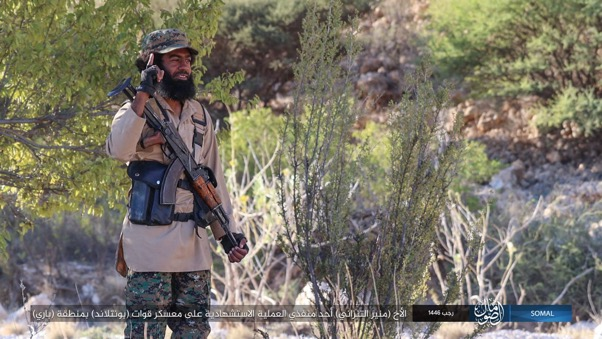
Munir at-Tanzani (Tanzanian)
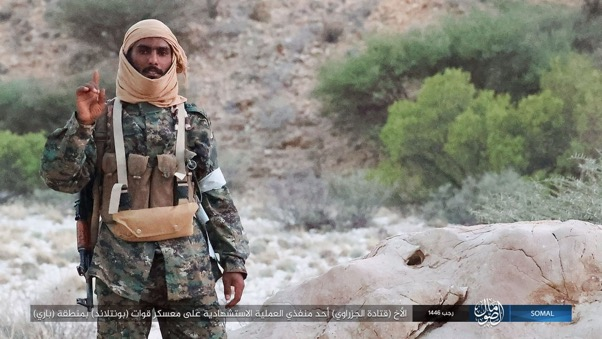
Qatada al-Jazrawi (Saudi)
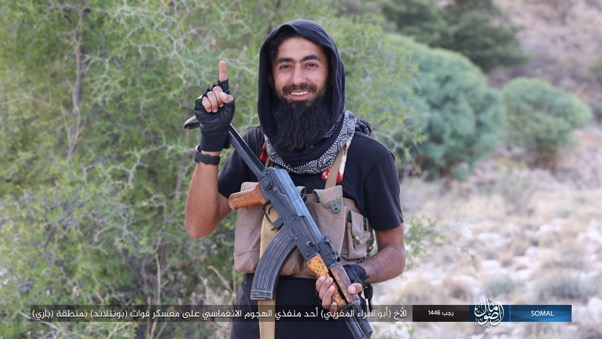
Abu am-Bara’ al-Maghribi (Moroccan)
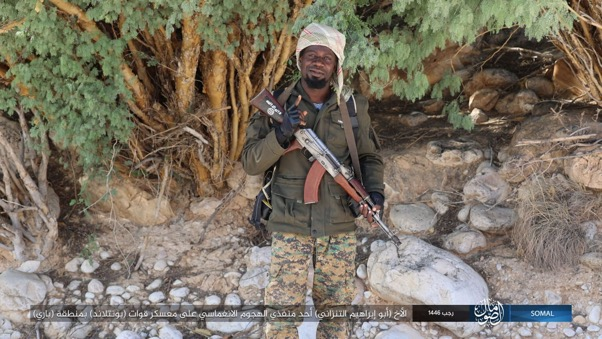
Abu Ibrahim at-Tanzani (Tanzanian)
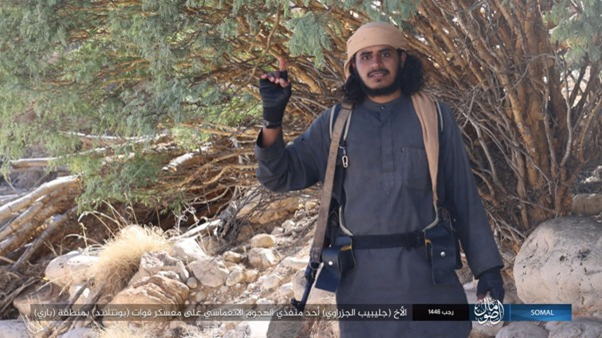
Julaybib al-Jazrawi (Saudi)
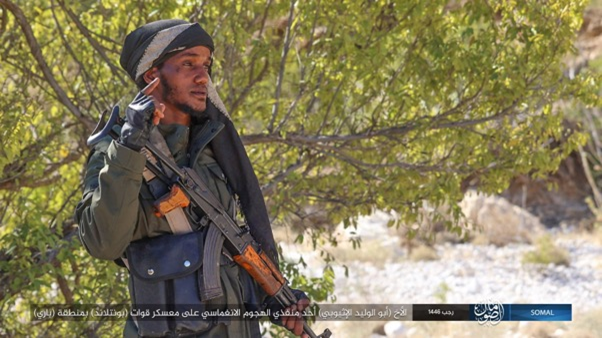
Abu al-Walid al-Ethiopi (Ethopian)

Abu az-Zubayr at-Tunisi (Tunisian)
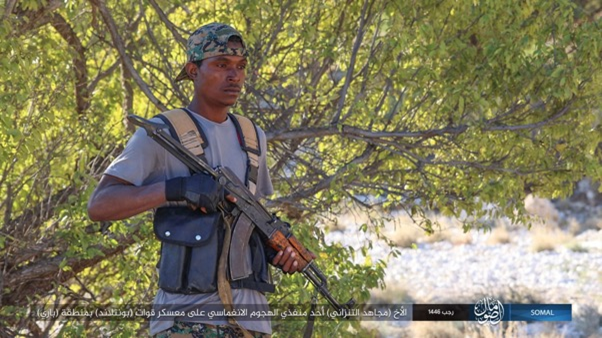
Mujahid at-Tanzani (Tanzanian)
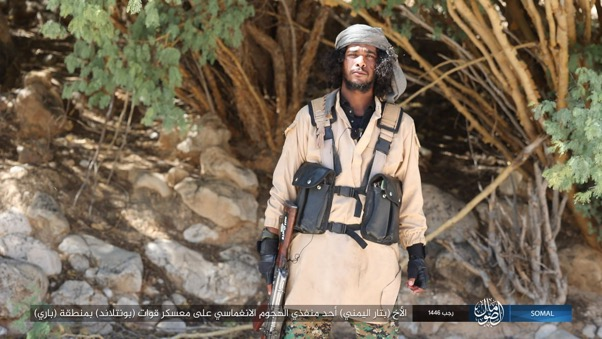
Battar al-Yemeni (Yemeni)
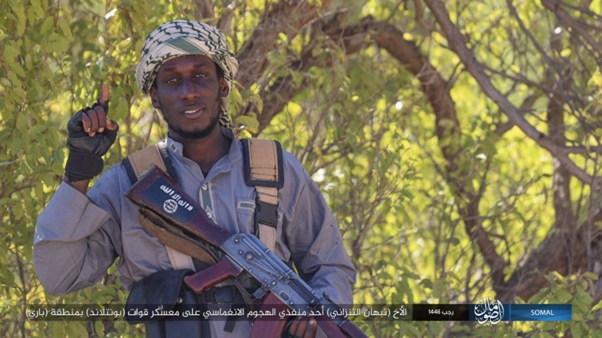
Nabhan at-Tanzani (Tanzanian)
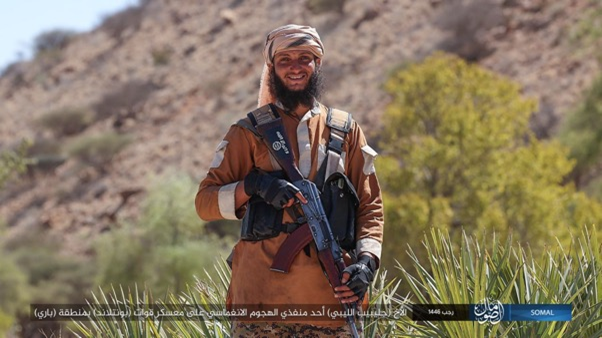
Julaybib al-Libi (Libyan)
This indicates that the threat posed by foreign terrorist fighters (FTFs), which was a hallmark of the al-Qaida affiliate in Somalia, al-Shabaab in the early 2000s, may become again a challenge for eastern Africa.
Signs of other significant developments have been ongoing for a few years. Since 2021, US Department of Treasury (DoT) has identified multiple links and groups affiliated with Islamic State Somalia through elaborate local and regional networks. Some exploited the close proximity to Yemen, to connect with the local Islamic State cells there and procure crucial supplies to modernise and arm the affiliate for the future war.
For example in March 2022, US DoT designated an operative closely working with IS Somalia network in South Africa, facilitating weapons procurement and sending recruits to training camps. In November 2022, the US identified networks engaged in illicit trading and smuggling resources via boats that seem to have multiple affiliations and worked on weapons procuring for al-Shabab, al-Qaida in the Arabian Peninsula (AQAP) in Yemen, IS Somalia and IS Yemen. One network had direct links to Iran, which further complicates the terror landscape, evident in UN monitoring team findings on Al-Qaeda affiliates in Yemen and Somalia cooperation with the Houthis.
In January 2023, US Special Forces conducted a land operation targeting the head of the most important IS structure in the region – the al-Karrar office, the main administrative and governing network for Africa, within the larger global body—the General Directorate of Provinces. Bilal al-Sudani, its first leader, was killed in a fortified cave compound. Materials found on-site, including his laptop, revealed important information for the global fight against the Islamic State. Not only has the al-Karrar office been involved in financing, instructing and guiding all affiliates in Africa, including the powerful Islamic State West Africa, it was also involved in the preparation of the bombing of Kabul airport in August 2021. Its money has taken multiple routes through Yemen, Turkey, Afghanistan, all the way to Europe. It is highly likely that some of it participated in financing the terror attack in Moscow in March 2024, widely thought to be the responsibility of Islamic State Khorasan Province. In June 2023 DoT published its “Fact Sheet: Countering ISIS Financing” stating that “ISIS networks in Afghanistan have continued receiving ISIS funds and represent a particular threat. Since late 2022 this financial support amounted to hundreds of thousands of dollars, including from now-deceased ISIS-official Bilal al-Sudani. In 2022, ISIS leaders allocated funding for ISIS-Khorasan external operations plots in Europe, and facilitators likely transferred specific funds to support successful attacks, including at least one in Russia.”
The flow of foreign terrorist fighters has been increasing significantly, with UN monitoring teams and officials in Puntland noticing the arrival and presence of foreign jihadists. In one case, a cell of Moroccans was arrested and later sentenced to death by Puntland authorities. In 2025, Moroccan security officials admitted that since 2022, over 130 Moroccan nationals may have migrated to Islamic State affiliates in the Sahel and Somalia.
It is important to highlight that in May 2024 the United States claimed—but in fact failed—to have killed Abdul Qadir Mu’min, considered to be the leader of IS Somalia Province. At that time, there was even speculation that Mu’min may be the new Caliph of the Islamic State. Mu’min however, a former leader of al-Shabaab, was appointed as the leader of the General Directorate of Provinces of the Islamic State, coordinating all international operations of the Islamic State. Under al-Baghdadi’s successor Abu Ibrahim al-Hashimi al-Qurayshi, this operational branch became an increasingly important institution within the organisation and now occupies a central position in the execution of external terrorist operations. Mumin was spotted in early 2024 while reportedly traveling several times to Yemen.
In the meantime, IS Somalia has witnessed a significant growth, with US officials warning that this Islamic State affiliate has nearly doubled in size in an extremely short time. At the time of writing the number of claimed clashes by IS as well as confirmed by the Puntland local government are steadily increasing and there is no immediate indication this will end soon. The ongoing air campaign of U.S. forces against IS in Somalia is another indication of the central role that this affiliate is increasingly playing in the Islamic State’s worldwide operations.
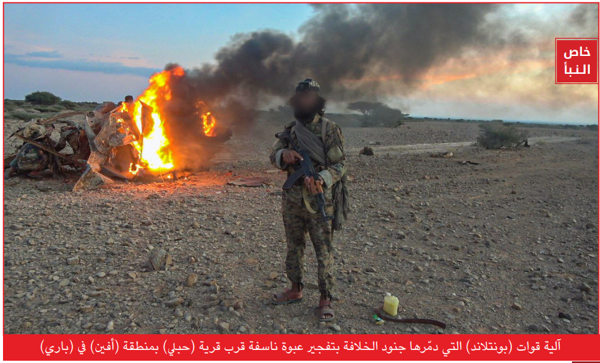
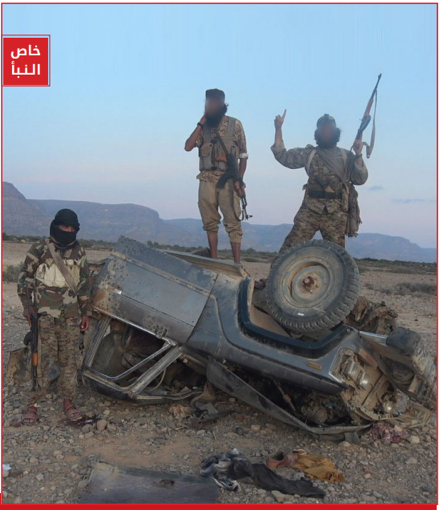
Pictures: an-Naba’ 479 - Following the suicide bombers from the end of December, Islamic State in its weekly al-Naba in mid-January presented another group of foreigners, posing before one of the destroyed Puntland vehicles.
Clashes continued with varying intensity until the latest U.S. airstrike that was authorised on February 1 by Donald Trump. This was the first U.S. airstrike against IS in the country since May 2024. The U.S. attack targeted one of the chief planners of the global Islamic State, an Omani emir that the U.S. had identified as an operative responsible for European and American terrorist operations, an indication of his importance in ISIS’ global chain of command. Since then, both the U.S. and the United Arab Emirates have taken increasing parts in Puntland's operation—as admitted by IS themselves.
Later in February 2025, IS continued to harass Puntland forces, publishing statements on attacks, though likely exaggerating some of their impact. Two large battles were reported on February 7 and February 13, 2025, showcasing the diversity and capacity of the terrorists. The latter attack in particular indicated the resilience of the terrorists, with yet another group consisting of dozens of foreign suicide bombers and a large number of Inghimasi-fighters (storm troopers). After a meticulously planned attack, with IS presenting in its propaganda output a drone view of Puntland forces’ gathering, the attack began, with IS claiming to have killed over 50 soldiers.
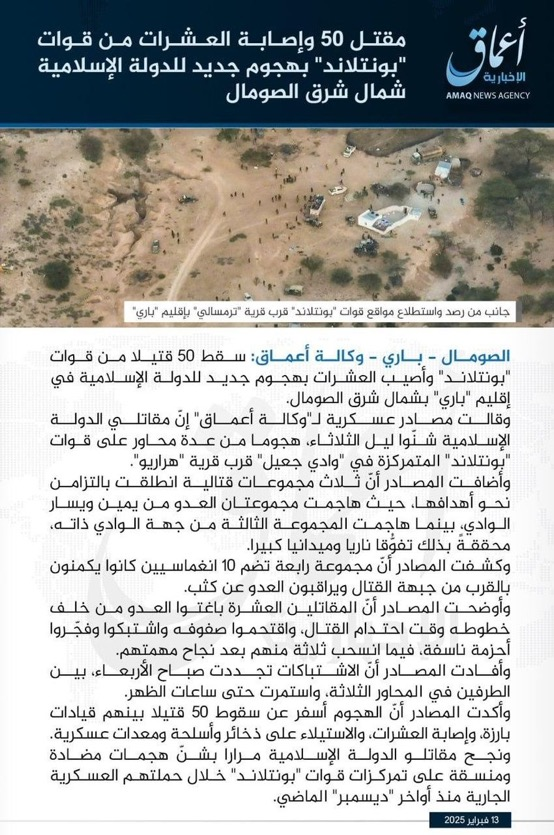
The Puntland Counter-Terrorism Operations room—on both Twitter and Telegram—has been updating the progress of its military gains against the Islamic State. Interestingly, the fighting seems to focus on a complex network of remotely located cave systems. Those contained multiple resources IS had prepared, ranging from usual military equipment, such as weapons, ammunition, reconnaissance and first-person-view (FPV) drones, to other supplies such as water, medications and infrastructures such as bakeries producing food on-site. The capacity of the Islamic State Somalia to procure such an abundance of resources showcase the extent to which the group has been organizing, preparing and planning despite the small size of territory it currently controls. Had they been given more time to operate in relative safety, it may have been possible that the group would not only have been able to challenge the local administration but also eclipse the influence of al-Shabaab in Puntland.
The military operations are continuing and are now reaching deep into Cal Miskaad mountains, with new UAE and American airstrikes reported on February 16, 2025, in the vicinity of two villages occupied by forces of the Islamic State. IS operatives are increasingly using armed drones, which hinders the progress of the opposing forces through the heavily fortified terrain. So far, Puntland has been able to eliminate over a hundred IS fighters, though the exact number is difficult to determine and verify. Frequent arrests of foreign terrorist fighters which are wounded, unable to fight or pressed to defect are also occurring. However, with supposedly over a thousand fighters left in the ranks of Islamic State in Puntland judging from estimates of the group's power it is far from clear how this current confrontation is going to end. First of all, it is not clear whether the Islamic State in Puntland is fighting seriously or whether the group is stalling for time, while sacrificing a part of its manpower and dispersing the rest to hide and reemerge once the Puntland forces are exhausted and the military pressure winds down. Recent UN report supports the notion of IS being able to replenish its ranks given the significant number of smuggling routes that remain intact.
In summary, it has become clear that this highly sophisticated attack at the end of 2024 in Puntland and the subsequent developments demonstrate once again the growing threat posed by the steadily growing activities of ISIS in Africa, in particularly in West Africa. The situation in the Sahel and Puntland as well as the ever-increasing number of attacks on the Christian population in eastern Democratic Republic of Congo are clear indications that Africa is slowly developing in to the new epicentre of ISIS’s global terrorist operations. It remains to be seen how ISIS will evolve in the near future now that Hayat Tahrir al-Sham has taken over power in Syria. For now, however, the number of operations claimed by ISIS in the African continent, has reached an all-time high.
Extremists: Their Words. Their Actions.
Fact:
On April 3, 2017, the day Vladimir Putin was due to visit the city, a suicide bombing was carried out in the St. Petersburg metro, killing 15 people and injuring 64. An al-Qaeda affiliate, Imam Shamil Battalion, claimed responsibility.
Get the latest news on extremism and counter-extremism delivered to your inbox.